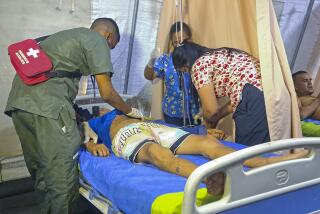Rumbling Volcano Perils Peru Villagers : Andes: Volcanologists warn newly active Sabancaya could erupt any day, endangering people on slopes below.
- Share via
MACA, Peru — When water came to this drought-stricken Andean village, it seemed like a miracle, but within a day it was clear it was an omen of disaster.
The water did not come from rain. It surged from an underground spring that started flowing through a crack in the village square this year. Within a day, half the village was flooded, and now Maca is sinking into the earth.
The crack was the result of tremors from Sabancaya, a nearby volcano that lumbered to life in August after several months’ dormancy.
The 19,720-foot Sabancaya has been rumbling off and on since 1987. In late April it began spewing gases, ash and rocks, sending up clouds 3 miles high.
More than 600 earth tremors a day kept farmers and villagers jittery until the volcano appeared to calm down in June. But volcanologists now warn it could erupt any day.
Sabancaya is 80 miles north of Arequipa, Peru’s second-largest city. Scientists say the city’s 500,000 people would not be endangered by an eruption.
But the people of the steep slopes and precipitous valleys around the volcano have a lot to worry about.
Mateo Casaverde, director of the Geophysical Institute of Peru, said an eruption would send a massive landslide thundering down the populated Colca and Siguas valleys, burying towns and fields along the way.
Thousands of tons of ice, mud and rock could shake loose from Sabancaya and the neighboring 20,790-foot mountain of Nevado Ampato, he said.
Casaverde believes the landslide could be of a similar magnitude to the one that buried the northern Andean town of Yungay in 1970, killing all 20,000 inhabitants.
Lava from Sabancaya represents no real threat, however. Volcanologists say the lava has never flowed farther than six miles from the crater in previous eruptions thousands of years ago.
Several thousand farmers and their families live in the shadow of Sabancaya in the villages of Maca, Pinchollo, Achoma and Cabanaconde. They are the ones Casaverde pinpoints as the first victims in an eruption.
Despite having been evacuated several times, the villagers always return to look after their crops of potatoes and corn and their livestock.
The known dangers are bad enough, but the geophysical institute also fears what it does not know. It said it lacks equipment and staff to predict when the volcano is going to erupt.
“We’re not experts,” said Leonides Ocola, who heads a team of volcanologists in Arequipa studying Sabancaya. “Just because some of our members have been to universities doesn’t mean we’re qualified to be studying the volcano. But if we don’t, no one else will.”
And the longer the villagers stay, the more they and their livestock are at risk. Several thousand head of cattle, sheep and llamas have already died from grazing on ash-covered vegetation.
Residents are also suffering from such respiratory illnesses as silicosis, caused by inhaling ash, carbon monoxide and sulfurous fumes, which have darkened skies in the area.
“If you think about it, they’re breathing the equivalent of ground glass,” Ocola said.
The volcano is also threatening Majes, a $1.1-billion irrigation project near Arequipa, one of the largest in the world.
“If it blows, I’m going to look for another job,” said Rafael Urday, head of operations at the 1.6-billion-cubic-foot dam that provides water for the Majes project.
Project coordinators fear an eruption could destroy miles of canals, causing millions of dollars in damage.
The Colca canyon, one of Peru’s biggest tourist attractions, would also be threatened by an eruption. The canyon plunges 11,220 feet, the world’s deepest gorge.
Nearby, village artisans embroider delicate and complex designs on skirts and blouses. Llamas wander through picturesque villages and ancient stone agricultural terraces.
The Colca valley also is sprinkled with ruins from the pre-Inca Huari culture.
The influx of tourists, already cut to a trickle by fears of a growing rural insurgency and highway robbery, could dry up altogether if towns and roads are destroyed by an eruption.
More to Read
Sign up for Essential California
The most important California stories and recommendations in your inbox every morning.
You may occasionally receive promotional content from the Los Angeles Times.










